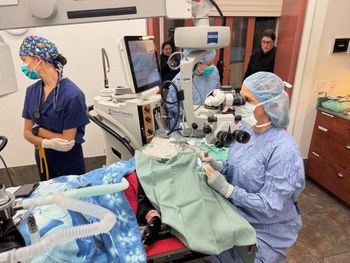
Hot Literature: Overlooked ocular pain: The benefits of using local anesthesia for enucleation
The results of a University of Wisconsin randomized controlled trial assessing the efficacy of retrobulbar analgesia on the control of postoperative pain in dogs undergoing enucleation was recently published.
Eye enucleation is known to be a painful procedure. In both human medicine and large-animal medicine, using retrobulbar local anesthesia is common. Small-animal veterinarians have yet to adopt this technique, even though enucleation is one of the most common ocular procedures. Using opioids to control pain is effective, but drawbacks include sedation, gastrointestinal complications, urine retention, and changes in body temperature-all of which can result in longer monitoring and recovery times. The alternative of inadequately treating pain in these patients can lead to various postsurgical complications including breakdown of the ocular repair.
An injection of a local anesthetic into the retrobulbar space is an easy, effective, and safe means of improving patient comfort and reducing hospitalization time. The results of a University of Wisconsin randomized controlled trial assessing the efficacy of retrobulbar analgesia on postoperative pain control in dogs undergoing enucleation was recently published in JAVMA.
In this study, 22 client-owned dogs undergoing enucleation were randomly divided into two groups (treatment and control). Dogs included in the study were free of other sources of pain, and a baseline pain score was obtained at the time of admission. The dogs in the treatment group received an inferior-temporal retrobulbar bupivacaine block 20 minutes before surgery. All of the dogs were premedicated with hydromorphone and midazolam, and general anesthesia was induced by using either propofol or thiopental and maintained with isoflurane and oxygen. Pain was evaluated at 15 minutes, 30 minutes, and then hourly for the first 24 hours after surgery. Any patients with a pain score greater than or equal to nine or with an individual category score greater than three were given a rescue dose of hydromorphone.
Postoperative pain control was much improved for the dogs in the treatment group. Only two of 11 dogs in this group required a rescue dose as compared with nine of the 11 dogs in the control group. Individual variation in response to the opioid premedication and differences in endogenous pain responses associated with painful, inflammatory states may account for the dogs in the treatment group that required rescue analgesia and the dogs in the control group that did not have treatment failure. No complications or toxicoses occurred with the use of the bupivacaine block.
Retrobulbar blocks are underused in small-animal veterinary medicine. However, as demonstrated in this study, when used as an adjunctive analgesic procedure in dogs undergoing eye enucleation, it can provide improved patient care and comfort.
Local anesthesia is an underused tool in small-animal veterinary medicine. However, as demonstrated in this study, when used as an adjunctive analgesic procedure, it may provide improved patient care and comfort.
Myrna KE, Bentley E, Smith LJ. Effectiveness of injection of local anesthetic into the retrobulbar space for postoperative analgesia following eye enucleation in dogs. J Am Vet Med Assoc 2010;237(2):174-177.
Link to abstract:
Newsletter
From exam room tips to practice management insights, get trusted veterinary news delivered straight to your inbox—subscribe to dvm360.




